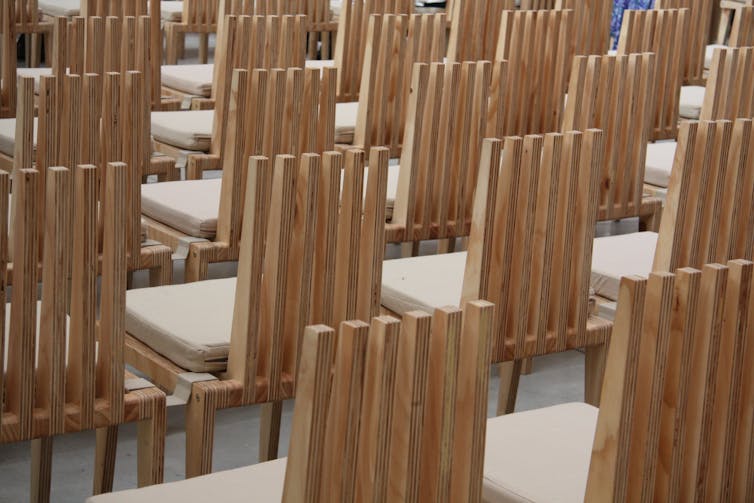American timber industry crippled by double whammy of trade war and COVID-19
- Written by Andrew Muhammad, Professor of Agriculture and Resource Economics, University of Tennessee
The forestry sector – landowners, logging companies and sawmills – have lost an estimated US$1.1 billion in 2020[1]. Devastating wildfires and Hurricane Laura have played a part, but the COVID-19 pandemic has also contributed to significant losses[2]. If workers are required to stay home, then no trees will be felled or logs sawed into lumber.
These losses have been exacerbated and amplified because of a longstanding trade war that has severely curbed the sale of U.S. forestry products to foreign markets, particularly China.
I am a professor of economics[3] with a specialty in international agricultural trade, trade policy and global food demand. My work at the University of Tennessee Institute of Agriculture is informed by my nearly 10 years as a senior economist with USDA researching international trade issues affecting agriculture and forestry.
The US-China connection
Forest product exports in the U.S., including logs and lumber, were valued at $9.6 billion in 2018, according to the U.S. Department of Agriculture[4]. Forest products are the third leading U.S. agricultural export sector after soybeans and corn. In 2018, China accounted for nearly $3 billion of U.S. forest product exports[5].
 Logs and more logs ready for market, some of which will end up in foreign countries like China for furniture manufacturing.
Photo by Mildly Useful for Unsplash, CC BY-ND[6][7]
Logs and more logs ready for market, some of which will end up in foreign countries like China for furniture manufacturing.
Photo by Mildly Useful for Unsplash, CC BY-ND[6][7]
The forest products relationship between China and the U.S. is complex. The U.S. sells logs and lumber to China; China uses the logs and lumber to produce finished wood products, such as furniture and hardwood flooring; and China exports these finished wood products to the world. Interestingly, the U.S. market is the leading destination for these exports. In 2018, U.S. imports of wooden furniture and other wood products from China exceeded $9 billion, according to the U.S. Census Bureau[8].
This raises an obvious question: Why doesn’t the U.S. simply make furniture and flooring? The answer is wages. The wage differential between U.S. and Chinese workers makes it more profitable to sell logs and lumber to China and then buy back finished wood products.
Since the demand for products like logs and lumber is directly linked to the demand for finished wood products like furniture and flooring, any decline in the latter negatively affects U.S. forest product exports. To say that what happens in China does not necessarily stay in China is an understatement.
A vulnerable industry takes the hit
COVID-19 has caused a major disruption on U.S. forest exports and hindered production because of lockdowns, business closures and production stoppages. Many of these supply disruptions started in China, where lumber was being turned into furniture, chairs and other goods where the pandemic began.
However, another major factor has been the interruption of demand because of decreased incomes and delayed purchases by consumers. In the U.S., furniture sales decreased as much as 66% in April 2020 when stay-at-home orders[9] went into effect. As of August of this year, U.S. imports of wood furniture and other wood products from China were down by nearly $2 billion, or 40%[10].
 COVID-19 has hit U.S. furniture sales hard, decreasing the global demand for U.S. timber, a primary input in furniture production.
Photo by Nareeta Martin for Unsplash, CC BY-ND[11]
COVID-19 has hit U.S. furniture sales hard, decreasing the global demand for U.S. timber, a primary input in furniture production.
Photo by Nareeta Martin for Unsplash, CC BY-ND[11]
Consequently, U.S. forest product exports as of August 2020 had dropped by more than $670 million overall, with exports to China down by more than $100 million. Geographically, most of these losses are in the South, a loss of $246 million, followed by the West, with losses of $183 million, and the Northeast, with losses of $143 million. In addition, these substantial losses are compounded by a multiplier effect that go beyond the raw export numbers.
In my state of Tennessee[12], for instance, the forestry sector provided nearly 100,000 jobs and had an annual economic impact of more than $24 billion in 2017, accounting for nearly 3% of Tennessee’s economy. This, of course, was before the COVID-19 pandemic and the U.S. trade war, which has devastated the forestry sector[13]. When considering the related activities associated with the forestry sector, such as trucking or equipment, total income and job losses are likely double the direct losses from export sales.
The economic fallout of the trade war
Prior to the pandemic, the U.S.-China trade war[14] had already made the forestry sector vulnerable because of the tariffs that the Chinese government imposed on U.S. timber and the resulting loss in exports. The industry was in a crisis when COVID-19 hit.
In 2018, President Trump ordered that tariffs be imposed on Chinese imports[15], including a 10% tariff on furniture and related goods from China. In retaliation, the Chinese government imposed tariffs on many U.S. agricultural goods, including 25% tariffs on U.S. logs and lumber. This double taxation resulted in nearly halving the export to China – from $3 billion in 2018 to $1.6 billion in 2019. The trade war, compounded by COVID-19, has had a major negative effect on forest products export sales – from timber harvest and lumber production to timber exports – which hurts working people including loggers and mill workers. Sawmills, in particular, have taken a serious hit.
How is this related to the current pandemic? In January 2020, the U.S. and China signed the Phase One Trade Agreement[16]. Based on the details of the agreement, timber and other forest product exports to China were expected to reach more than $4 billion in 2020. The fact that current export sales to China, as of August of 2020, were only $1 billion suggests that COVID-19 is having an even larger impact than the numbers reveal.
References
- ^ US$1.1 billion in 2020 (www.whitehouse.gov)
- ^ significant losses (extension.tennessee.edu)
- ^ professor of economics (scholar.google.com)
- ^ U.S. Department of Agriculture (apps.fas.usda.gov)
- ^ U.S. forest product exports (apps.fas.usda.gov)
- ^ Photo by Mildly Useful for Unsplash (unsplash.com)
- ^ CC BY-ND (creativecommons.org)
- ^ U.S. Census Bureau (usatrade.census.gov)
- ^ stay-at-home orders (extension.tennessee.edu)
- ^ $2 billion, or 40% (usatrade.census.gov)
- ^ CC BY-ND (creativecommons.org)
- ^ Tennessee (extension.tennessee.edu)
- ^ forestry sector (extension.tennessee.edu)
- ^ U.S.-China trade war (extension.tennessee.edu)
- ^ tariffs be imposed on Chinese imports (extension.tennessee.edu)
- ^ Phase One Trade Agreement (www.fas.usda.gov)
Authors: Andrew Muhammad, Professor of Agriculture and Resource Economics, University of Tennessee

